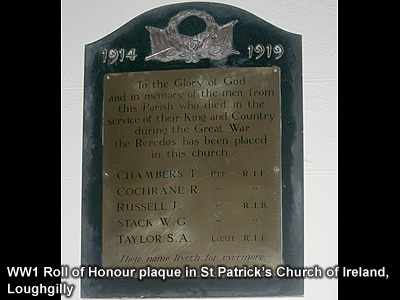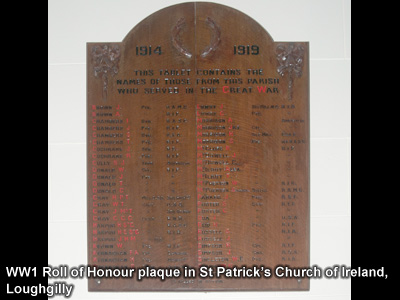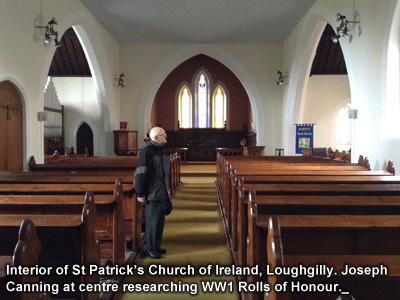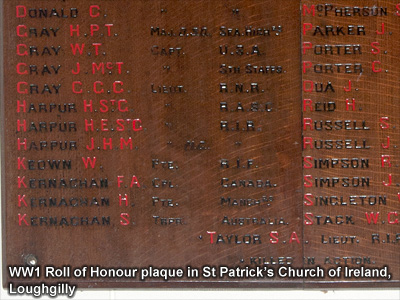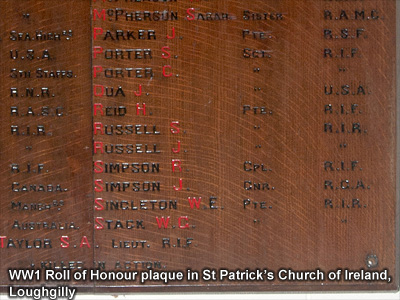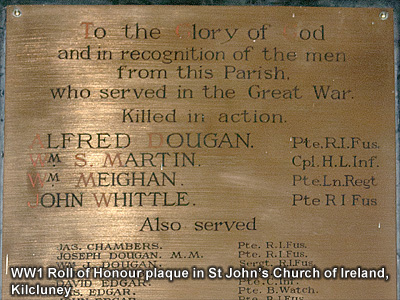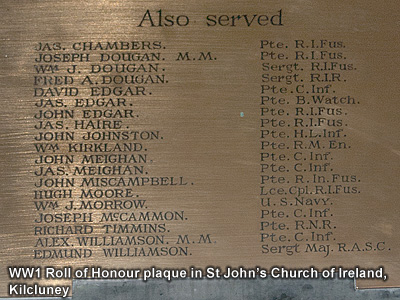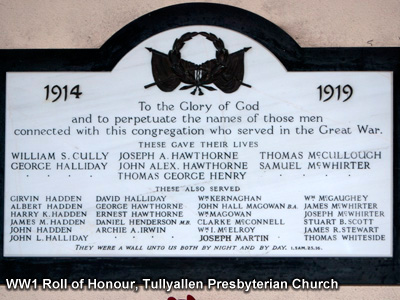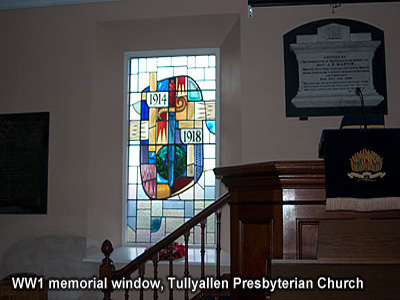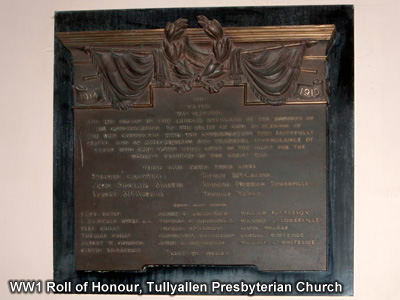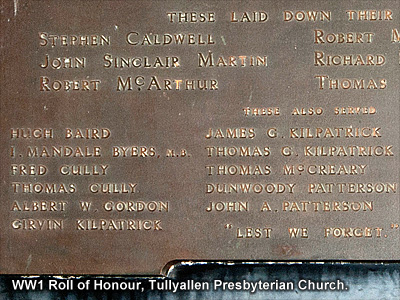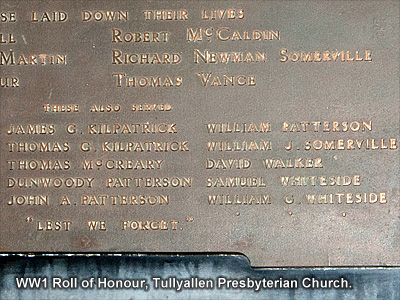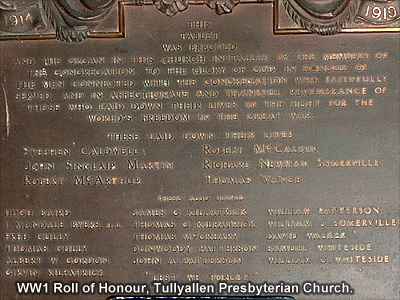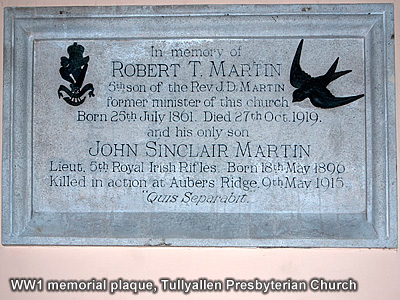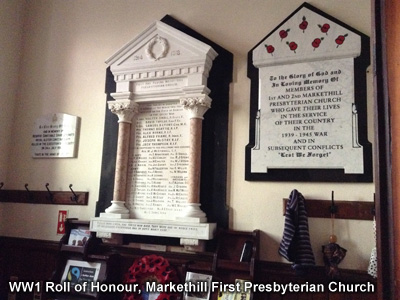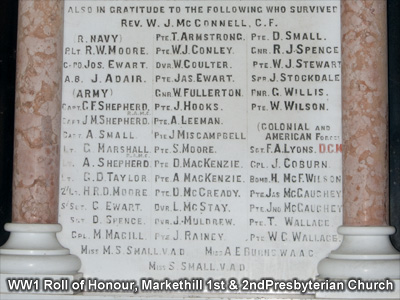
Despite the fact that another war was waged later in the century, which lasted longer and in which more sophisticated and destructive weaponry was used, the conflict between 1914 and 1918 is still spoken of as “the great war”. There are many reasons for this. One, no doubt, was because of the number of casualties involved; there was a total of 10 million, 6 million of the Allies and 4 million of the Central Powers (Germany, etc.).
As Ireland was then part of the United Kingdom, it was expected to make its contribution to the armed forces. 206,000 Irishmen served during the war, of whom about 30,000 died. However, most of the those who joined were from the province of Ulster. Here 30,000 members of the Ulster Volunteer Force joined up virtually en masse to form the 36th (Ulster) Division. The most enduring legacy of Irish participation in the war resulted from the Ulster Division’s part in the battle of the Somme, which began on the 1st July 1916. In the first two days of the battle the division suffered 5,000 casualties, a ‘blood sacrifice’ which came to represent for unionists conclusive proof of their unshakeable loyalty to the Union, and which is celebrated annually at the beginning of July.
As the regular army along with the reserve could not provide adequate manpower for the conflict, an extensive recruiting campaign had to be undertaken. This took many forms. Posters, with wording specially chosen to ensure an enthusiastic response, were displayed in strategic places, and advertisements with a similar message were inserted in local newspapers. This is an example from the Ulster Gazette:

A special recruiting committee was set up in each county and meetings were held in the towns and villages; these meetings continued to be held right through the war. The same newspaper has this description in its issue 1st July 1915:
Under the auspices of the County Recruiting Committee a recruiting meeting was held in Markethill on last Monday last. The notice for the meeting was very short, but owing to the energy displayed by the honorary secretary for the county, Mr T. E. Reid, ably assisted by Mr Robert Hampton and Sergeant McMullan, it received a great deal of publicity, and was well attended. Two military bands were present – that of the Connaught Rangers being with the official recruiting party. The other band was that of the 2nd Battalion Royal Irish Fusiliers. The recruiting party were driven to Markethill in motors kindly lent by Messrs. M. Sinton, J.P. and A. C. McBride.Previous to the meeting the bands paraded through the town through Newry Street and Main Street and back again.
The chair was occupied Mr Samuel Byers, J.P., who in a few introductory remarks, explained the object of the meeting and urged on all present the necessity of rallying round their country during the present crisis. If they did not there was no knowing what might be the consequences.
The speakers included Captain Hughes and Lieutenant Burns of the Connaught Rangers, Rev. H. H. Moore, B.A., and Sergeant Major Lahilly.
Several recruits joined . . .
The exact number of recruits from this area is not known but it is safe to assume that it compares favourably with the rest of Ulster. However, one place in particular made a significant contribution, namely Glenanne. In July 1915 there were 20 men from there in the army. They included the nephew of the owner of the factory, while the remainder worked in the factory themselves or their parents did. The camaraderie that would have existed among the staff of a factory probably encouraged so many to join up, but it is possible that they would have seen life in the army as an escape from the boredom of their work.
It was stated earlier that there had been almost unanimous response from the UVF to the call to join up. However, it is well established that some of the members had serious reservations about doing so. There were some of these in this area. At Hamiltons Bawn the Rev. McLaughlin, who was in charge of the local company, tried to encourage his men to enlist by pointing out to them the positive response by their colleagues in other parts of the province. However, the men refused to enlist and their attitude is expressly clearly in a letter to their regimental commander when their representative states:
[H]e told us that himself & his son had offered their services to the Government to go to the front and was accepted and that we might not see him again and he told us nothing about what we were to do so practically we are left as sheep without a Shephard no Instructor no section leader no one to give us advice[H]e pressed us very hard to sign our services to the government but no one done so he told us that over 2,000 U.V.F. Co Tyrone were going to the front and that a batallion of 800 Belfasts was for the front[. W]e came to the conclusion that we signed the covenant to defend Ulster against a Dublin Parliament & any of our commanders who asks us to leave Ulster or to fight for this Notorious Government now in office is betraying Ulster men & women worse than Lundy in Derry...(Armagh County Museum, Armagh UVF Papers, Ms. 56, 1960).
Because of the number involved it is possible to give details of only a few of those killed.
Three men from Glenanne were among the dead of 1st July 1916 in an attack at the same place.
Thomas Chambers was the second of the three sons of Thomas and Mary Jane, who both at one time worked in the factory. Thomas enlisted in September 1915 and was posted to 9th Battaliion, Royal Irish Fusiliers in May or June 1916. He was killed at the attack on Hamel. At the time of his death he was aged 19. He had a brother, a cousin and two uncles at the front serving with the 36th (Ulster) Division.
Samuel McWhirter was the sixth of the eight sons of James and Mary. James and four of his sons were employed in the factory. Samuel enlisted in September 1914 and went to France in October with the 36th (Ulster) Division. He was wounded in the attack on Hamel on 1st July, but died later of his wounds on the same day. Two of his brothers also served.
Thomas Vance was the second of the two sons of Thomas and Mary; there were also four girls in the family. Thomas (senior) and three of his daughters also worked in the factory. Thomas enlisted in September 1914 and went to France in October 1915. He died in the same circumstances as his two neighbours, being twenty-three years old at the time of his death.
For the families of the deceased soldiers the deaths of young members far from home was obviously a source of great sorrow, and this sorrow must have been magnified in the case of those soldiers whose bodies were never found. Particularly sad for his family must have been the death of Walter Small. He was the son of William (an extensive farmer, JP and one time land commissioner) and his wife Sara. The family lived in the townland of Lattery, about a mile outside Markethill. Walter joined the Royal Scottish Fusiliers and rose to the rank of second lieutenant. He took part in the battle of the Somme and during the attack on the town of Guillemont on 30th July 1916 he volunteered to carry a despatch; he was reported missing on 1st August. Sadly, he had walked on a hidden unexploded shell and his body was blown to bits. His family erected a memorial plaque in his memory in First Markethill Presbyterian Church.

There was also the occasional happening of a family being left without a bread winner. This was the result of the death of William Cully. He was from Tullyallen and was a farm labourer. He joined the Royal Irish Fusiliers and he too died on 1st July 1916. The first official report that his wife received was that he was missing but his death was confirmed in early September. He left behind a family of five sons and two daughters; fortunately some of the older members were in employment in Glenanne factory.

Many of those who returned home from the front did not survive for long because of the wounds which they had received. However, most were able to lead normal and useful lives, many still retaining the scars of battle. Two of these illustrate the different experiences of survivors.
Joseph Lowry was the son of Richard and Susan, being the eldest son in their family of three sons and four daughters. At the time of the 1901 census Richard and one of his daughters are engaged in the linen industry while Joseph is described as an unemployed clerk. In April 1903, he enlisted in the Gordon Highlanders, and in November of the same year he was sent out to India, where he spent seven years. He returned home in January 1911, and was subsequently in the Reserve. On the outbreak of war he rejoined the army with the Royal Irish Rifles and was shortly after sent to the front. He took part in a succession of battles in October and November 1914, and was wounded in the battle of Ypres. At the end of that year he wrote a long letter to his father in which he described his experiences which included a face-to-face encounter with a German soldier; he concluded by saying that it was time to bring in conscription as it was a “profound disgrace” to see the number of young men not interested in joining up. He took part in the battle of the Somme, and in August 1916 he was awarded the Military Cross. The citation states that it was given “in recognition of his conspicuous bravery and devotion to duty. His bravery is always cool and soldier-like under fire”. When he returned home he was somewhat disillusioned. He did obtain some gainful employment but it was not in keeping with his experience and talents. Part of this employment was in the Post Office in Makethill where one of his colleagues was Sam Heatherington who appears elsewhere in “Bygones and Byways". When World War II started Joseph was employed to train soldiers.
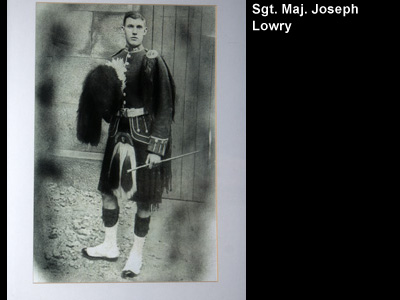
Sir John Hall Magowan was the son of William Hall Magowan, farmer and auctioneer, Mountnorris, and his wife Sarah Ann. John was the eldest in a family of four boys and two girls. He was educated in the Royal School, Armagh and Trinity College, Dublin. He entered the army in the Royal Field Artillery and served in an intelligence post during the war. He was wounded and mentioned in despatches. In March he was despatched to a Reserve Brigade in Cork. After the war he joined the consular service and between then and 1937 he served in Germany, Haiti and the United States. In that year he graduated to the diplomatic service and was sent to Berlin as commercial secretary. During his two years here he made a celebrated report on economic conditions in Germany during the earlier years of the Nazi regime. On his return to England he served in a department relating to exports. In 1942 he was moved to Washington where he remained until 1948. In that year he was appointed ambassador to Venezuela, a post he held until December 1950. In that month his transfer to Bangkok was approved. However, while at home on holidays in Rostrevor, he died suddenly on 3rd April 1951, aged 57. He was survived by his wife, two sons and a daughter.
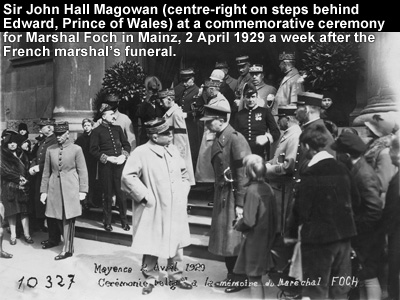
As the names so far recorded are all from the Protestant/Unionist community it might be thought that no Catholic/Nationalists took part. However, that would not be true as this community did make a contribution, even though it was a small one. It has been difficult to discover names but as a result of oral inquiries a few names have been discovered: the brothers Francis and James McParland, John McGeown and Arthur Rocks (all from Markethill and District), Daniel McParland (Ballymoyer) and Thomas Pickering (Mullabrack).
There were many ways of commemorating the military service of those who had fought. Some families of victims would compose a verse to be inserted with the obituary of the loved one in the local newspaper. The newspapers also provided an importance service by publishing regularly a “Roll of Honour”. This was done all during the war and for months afterwards. The list included not only victims but also those who were mentioned in despatches, wounded, imprisoned and missing and those who had been given awards.
The Presbyterian Church in Ireland collected the names of all its members who had taken part, and had them published in a book, listing them by presbytery and then by congregation.
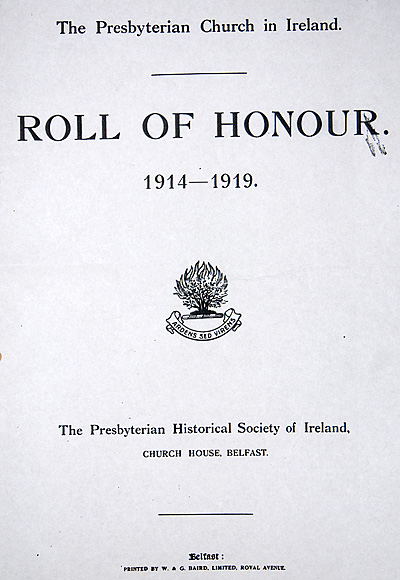
The most public form of commemoration was the erection in town centres of monuments, usually containing the names of the local heroes, and providing a venue for the annual commemorations in November. Unfortunately, no such monument exists in Markethill, but it is something which should be given consideration, particularly in these centennial years.
The initiative of the Presbyterian Church has already been mentioned but the individual congregations of this Church along with the parishes of the Church of Ireland have ensured that their members are remembered locally. In most of the churches a memorial plaque recording the names of those who served in the war has been installed.
The survivors of the conflict had many needs which had to be provided for. Here, only housing will be considered. An Act of Parliament, entitled the Irish Land (Provision for Sailors and Soldiers) Act received Royal Assent on 23 December 1919. This provided for the construction of houses for ex-servicemen. Ten houses were erected in the Markethill area between March 1921 and July 1922—one each in the townlands of Drumilt and Maytone, two in Tullyallen and six in Markethill. Those in Markethill were on the Mowhan Road and most of them still survive.
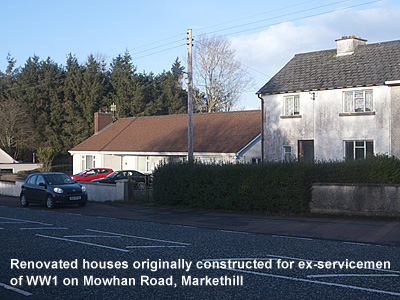
In the accompanying audio recording, James Magowan of Ballygorman, talks about his home, his grandfather, Sir John Hall Magowan (who fought in WW1), and his father's experiences in WW2 as an airforce navigator (13 min 44s).
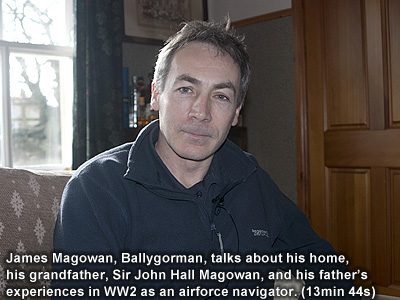
Use the audio controller to listen to this talk, given in 2014.
In the accompanying audio recording, Colin Lowry of Glenanne, talks about his grandfather's WW1 and WW2 army careers (9min 28s).
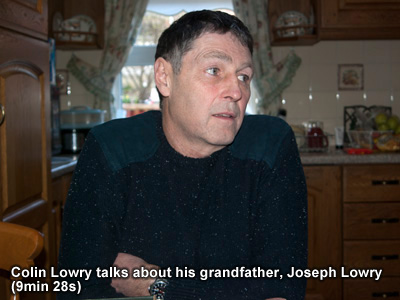
Use the audio controller to listen to this talk, given in 2014.
